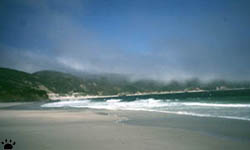
Unnamed beach, San Miguel Island.
Part 8. The Channel Islands
Channel Islands off California are clearly visible from the shore between Santa
Barbara and San Diego, but they are a world apart from the busy mainland. The
northern part of the archipelago, once part of the seafaring Chumash Indians'
domain, is now mostly uninhabited and protected by National Park Service and The
Nature Conservancy. The southern part, originally Gabrielino Indian homeland,
is now mostly owned by US Navy and private landowners.

View of Santa Rosa from San Miguel. |
These beautiful islands were probably
one of the first places in America to be colonized by humans. It happened at least
11,000, and possibly 30,000 years ago, when some of them were connected. |
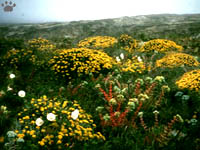
Oceanic meadows, San Miguel Island. |
 |
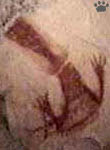 |
 |
| Chumash Painted Cave
near Santa Barbara. Some of this frescoes apparently depict the solar eclipse
of 1677. |
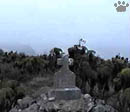
Joao Cabrillo monument,
San Miguel Island. |
The islands were also the first part
of Alta California to be discovered by Europeans. Joao Cabrillo landed here in
1542. The Indians were all dead or resettled by the early XIX century. Overgrazing
by introduced cattle turned most islands into wasteland. Now their green cover
is slowly coming back, but numerous introduced species are still a big problem. |
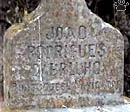
Joao Cabrillo monument,
San Miguel Island. |
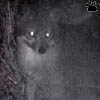
Island fox,
Santa Cruz Island. |
Originally the islands were inhabited
by pygmy mammoths, but since Indian times the largest land mammals here are island
fox (Urocyon littoralis) and the island subspecies of Western spotted skunk
(Spilogale gracilis amphianus). The only other land mammals are deer mouse
(Peromyscus maniculatus) and Western harvest mouse (Reithrodontomys
megalotis santacruzae). |
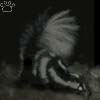
Western spotted skunk,
Santa Cruz Island. |
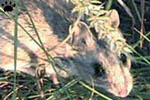
Deer mouse, San Miguel. |
There were once different subspecies
of island fox and deer mouse on almost every island, while the other two species
only lived on Santa Cruz - the largest (250 sq. km/96 sq. miles) and the most
diverse of the Channel Islands. |
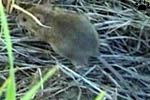
Western harvest mouse, Santa Cruz. |
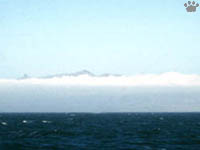
View of Santa Cruz from Santa Rosa. |
Santa Cruz is also the highest island,
with mountains rising to 730 m, and rugged shoreline. Its coastal cliffs are dotted
with grottoes, including some of the World's largest sea caves. |
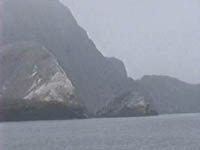
Rugged coast of Santa Cruz. |
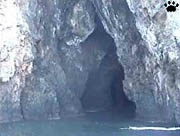 |
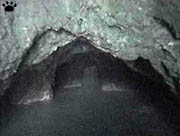 |
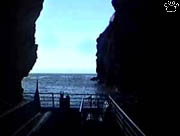 |
| Painted Cave is 500 m long, and large
enough for small ships to enter. |

Bald eagle,
Santa
Cruz I.. |
Unfortunately, the tiny island fox
is now almost extinct on all Channel Islands except San Nicolas and San Clemente.
As native bald eagles (Haliaeetus leucocephalus) died off in the 1970-s
because of DDT poisoning, the islands were colonized by golden eagles (Aquila
chrysaetos). Unlike bald eagles, they preyed on foxes. On San Miguel, the
fox population dropped from about 500 to just one (18 more exist in a breeding
facility). There are efforts underway to remove golden eagles, re-introduce bald
eagles, and captive-breed the foxes, but it is all very difficult. |

Golden
eagle,
Santa Rosa. |
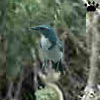
Island jay,
Santa Cruz Island. |
Santa Cruz also has the islands' only
endemic bird species, the island scrub-jay (Aphelocoma insularis). Ten
more bird species are reprsented on Channel Islands by endemic subspecies. One
of them, Santa Barbara song sparrow (Melospiza melodia graminea), is extinct,
and a few more are endangered. |
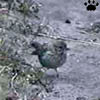
San Clemente song
sparrow, San Miguel. |
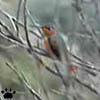 |
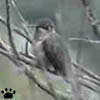 |
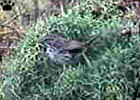 |
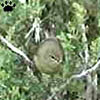 |
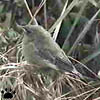 |
Channel Islands hummingbird
(Selasphorus
sasin sedentarius), male and female, San Miguel. |
San Clemente song sparrow
(M. m. clementiae), San Miguel. |
Channel Islands warbler
(Vermivora celata
sordida), San Miguel. |

Part of Anacapa Islands. |
Smaller islands, such as Anacapa, Santa
Barbara, and Prince Island, are important seabird nesting areas. They are also
among the most beautiful diving sites in all of California. |

Islets off San Miguel. |
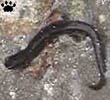
Channel Islands
salamander, San Miguel. |
There are very few reptiles and amphibians
on the islands, and most of them are difficult to find. Two species are endemic:
island night lizard (Xantusia riversiana) and Channel Islands slender salamander
(Batrachoseps pacificus), one of the smallest in California. It is usually
only 2'/5 cm long. |
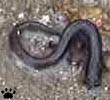
Channel Islands
salamander, San Miguel. |

Santa Rosa Island. |
Santa Rosa Island has relatively poor
fauna, but its flora is very diverse, and includes all three pines of Channel
Islands: Bishop pine (Pinus muricata), Santa Cruz pine (P. remorata),
and Torrey pine (P. torreyana var. insularis). |

Torrey pine grove, Santa Rosa. |

Torrey pine,
Santa Rosa. |
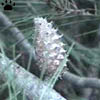
Bishop pine,
Santa Cruz. |
There are approximately
1,000 species of vascular plants on the islands, and at least 150 of them don't
occur anywhere else, although some, such as liontree (Lyonothamnus floribundus)
and island oak (Quercus tomentella), have been much more widespread in
the past. |

Island oak,
Santa Cruz. |
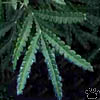
Liontree,
Santa Cruz. |
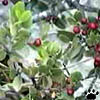
Island redberry
(Rhamnus pirifolia),
Santa Rosa. |

Santa Cruz wild lilac
(Ceanothus arboreum),
Santa Cruz. |
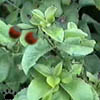
Catalina cherry
(Prunus lyonii),
Santa Cruz. |
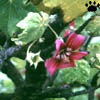
Tree mallow (Lavatera
assurgentiflora),
San Miguel. |
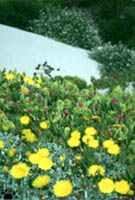
Dune vegetation, San Miguel. |
Windswept San Miguel island has no
trees, but it is probably the best place to see Channel Islands wildflowers.
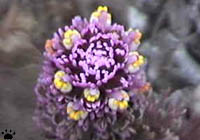
Owl clover (Castilleja exserta), San Miguel. |
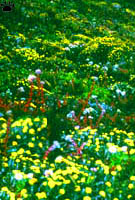
Coastal meadows, San Miguel. |
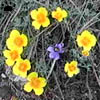
Island poppy
(Eschscholtzia ramosa),
San Miguel. |
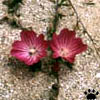
Island cockle
(Agrostemma cruzae),
San Miguel. |
Its dunes, meadows and canyons are
almost permanently covered with cool fog, which provides more moisture for plants
than in any other place in Southern California. |
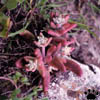
Island dudleya
(Dudleya nesiotica),
San Miguel. |
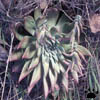
Green dudleya
(D. candelabrum),
San Miguel. |
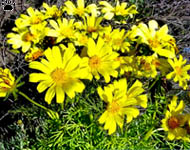
Giant coreopsis, Santa Barbara. |
The closest thing to a tree on San
Miguel is giant coreopsis (Coreopsis gigantea). Outside coreopsis groves,
San Miguel sagebrush (Artemisia californica caryss) is one of the most
common plants. |
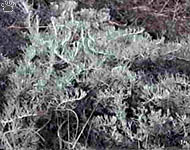
San Miguel sagebrush, San Miguel. |
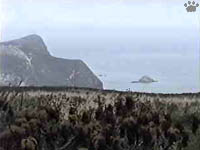
San Miguel Island. |
The westernmost of all Channel Island, San Miguel
is also the coldest, the most remote, and the less visited - probably the most
desolated place in Alta California. It is also my personal favorite. |
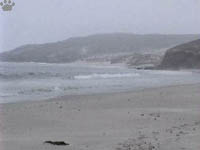
San Miguel Island. |
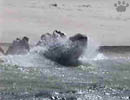
Surf landing by zodiac,
San Miguel. |
The only way to get to the island is by an occasional
boat tour, which includes surf landing and surprisingly rustic camping. Island
trails are steep and slippery, so it is not unusual for visitors to get back to
the mainland by medevac helicopter. |

Emergency evacuation,
San Miguel. |
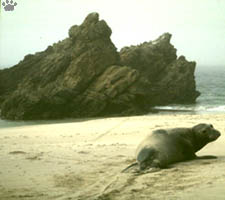
Elephant seal, San Miguel. |
The island has the world's largest caliche forests
- areas of caliche sand castings of tree trunks and roots. Nobody knows how exactly
were these castings formed. |
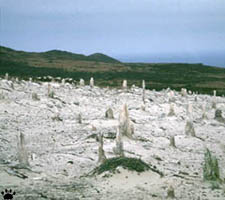
Caliche forest, San Miguel. |
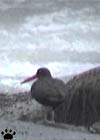
Black oystercatcher,
San Miguel. |
San Miguel is the best place in the Southern part of Alta California to see
marine mammals. Up to 20,000 pinnipedes of six species gather on Point Bennet;
thousands more can be seen on other island beaches. Northern elephant seals (Mirounga
angustirostris) are particularly numerous. Whales, dolphins and sea otters
can often be spotted from coastal cliffs. See Marine Mammals
page for more details. There are also lots of seabirds and shorebirds, such as
black oystercatchers (Haematopus bachmani).
|
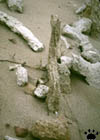
Caliche forest,
San Miguel. |
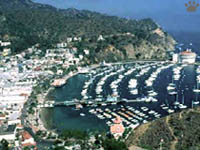
Avalon City, Catalina Island. |
I hope the Northern Channel Islands
will never share the fate of Catalina Island in the south - now a popular seaside
resort (although much of its territory is protected by The Nature Conservancy). |
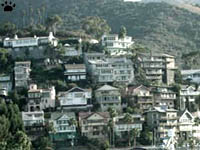
Avalon City, Catalina Island. |

Coast of San Miguel Island. |
Back to part 7
Home
|